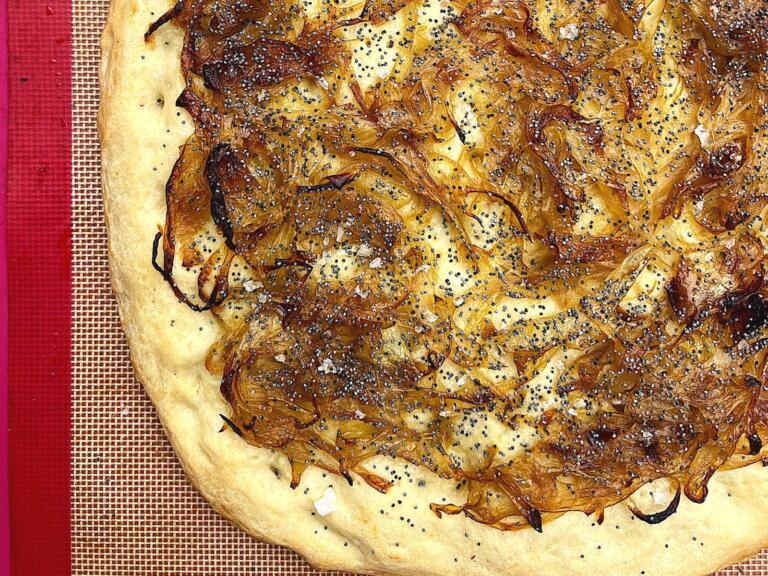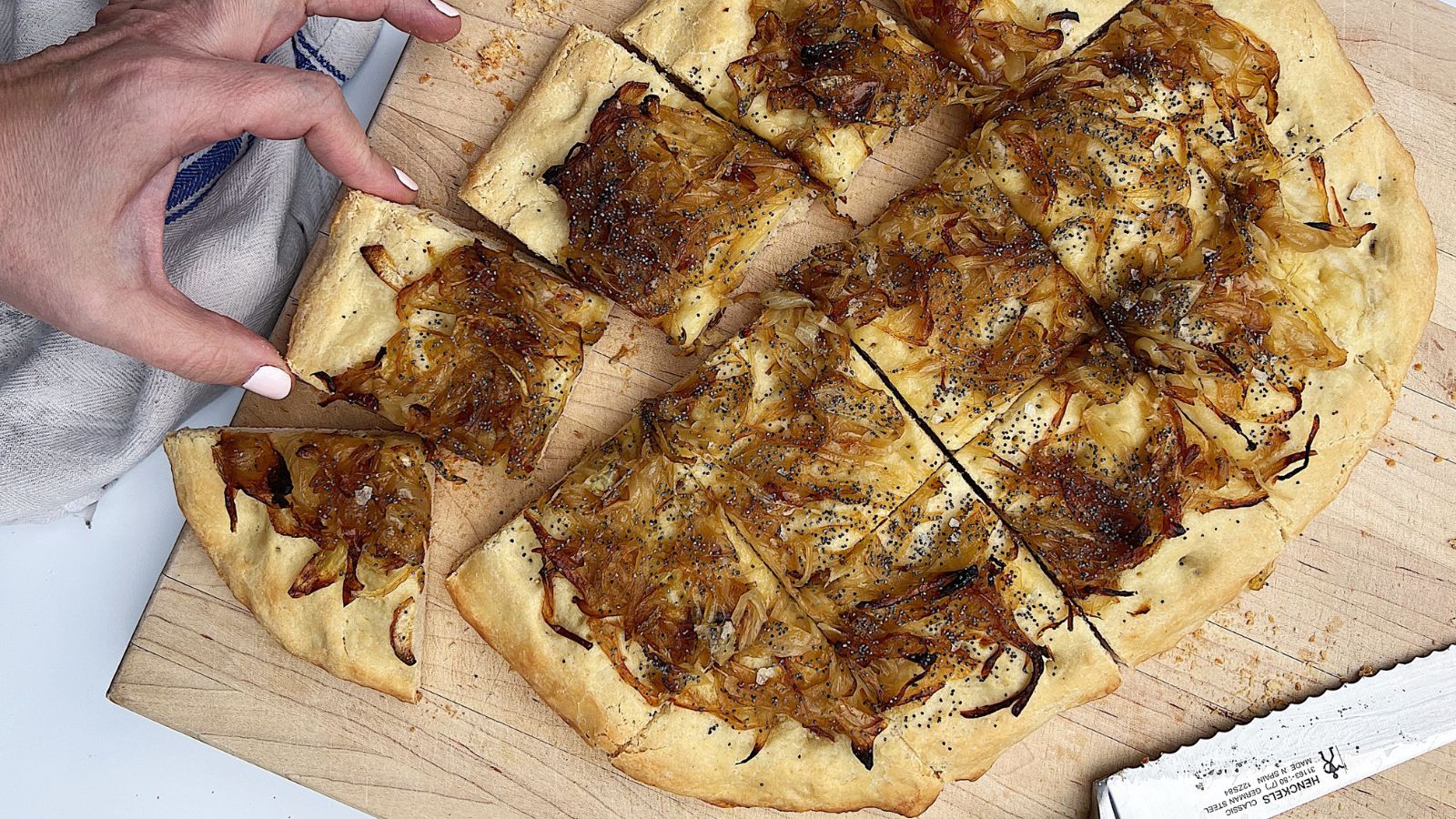For years, you could find pletzl, a flatbread topped with raw or caramelized onions and poppy seeds, sold alongside bagels and bialys at Jewish bakeries along the East Coast. Pletzl was brought to the U.S. by Polish, Lithuanian and Ukrainian Jews in the mid-20th century, but the bread never seemed to capture the American palate the way bagels have, and it slowly faded into semi-obscurity.
Pletzl (aka onion board or platzel) is typically made from flour, yeast, oil, salt and water. In “The Encyclopedia of Jewish Food,” Gil Marks explains how this bread, the texture of which can be thin like a cracker or light and airy with a more focaccia-esque crumb, gained popularity in the 19th century, as Eastern European Jews gained access to modern milling equipment and techniques that allowed them to move beyond the rye bread they were accustomed to and toward lighter flatbreads.
Pletzel’s exact origins are unclear, but we can fairly reliably connect them to their successors, bialys, which Mimi Sheraton, food critic and author of “The Bialy Eaters,” theorizes was born from a pletzel gone rogue:
“My theory is that a pletzel, having been formed but not baked, fell on the floor and somebody stepped on it with the heel going into the center, and being frugal decided to bake it anyway and see what happened. And so, the bialy was born.”
The Nosher celebrates the traditions and recipes that have brought Jews together for centuries. Donate today to keep The Nosher's stories and recipes accessible to all.
Linguistically, Marks connects pletzl to German plätzchen (crackers). He also notes that the origin of the term “onion board” is likely due to the fact that the flatbread would’ve been formed on a baking board, known in Yiddish as a lokshen bretl. Bretl, Marks suggests, sounds similar to pletzel.
You can still find this tragically underrated bread — if you know where to look. These days, rather than the traditional oblong shape formed on a baking board, some bakeries sell pletzlach as rolls or discs, which more closely resemble the bialy. Kossar’s Bagels and Bialys in New York sells an almost pizza-like circular version, which, thanks to the miracles of same-day shipping, is available to order via Goldbelly.
The Yiddish word “pletzl” means ‘little place,” and it’s also the former name of the Jewish quarter in the 4th arrondissement of Paris. There, on Rue de Écouffes, Florence Kahn sells a pletzel sandwich from her eponymous bakery. Though traditionally pletzel were served whole with a schmear of cream cheese or chopped liver on top, Khan cuts hers down the middle to make a sandwich, filled with pastrami, turkey or corned beef, topped with a variety of vegetables. Following suit, Joe Baur uses pletzl to play on the Iraqi-Israeli sabich sandwich, with silky eggplant and flavorful amba.
Pletzl is simple to make at home. Like many historical recipes, there are plenty of discrepancies. “There are at least eighteen or so varieties of pletzl,” Marks writes. “The most famous one is topped with the principal Ashkenazic seasoning, onions (tzibele); it is known as tzibele pletzl; tzibele zemmel, tzibele papalik, and simply pletzl.” There are also sweet pletzels without onions.
While Kahn’s pletzl dough is enriched with eggs and sugar, Leah Koenig’s recipe in “Modern Jewish Cooking” (as well as my recipe below) omits egg in the dough and tops the flatbread with pre-cooked onions. More than the dough itself, it’s the ease of cooking that seems to be a common thread among pletzls. Whether you whip up a quick dough of flour, yeast, salt and water or use a big pinch of your Shabbat challah dough, the idea is the same.
Note: Bread will last for 2-3 days in an airtight container on the counter.

Pletzl Recipe
Try this Ashkenazi flatbread topped with onions and poppy seeds for your next dinner party.
- Total Time: 13 hours 20 minutes
- Yield: Serves 8
Ingredients
For the dough:
- 1½ cups warm water
- 2¼ tsp active dry yeast (1 packet)
- 2 tsp granulated sugar
- 2 tsp kosher salt
- 3½ cups all-purpose flour
- 2 Tbsp olive oil, plus more to coat the dough
For the topping:
- 3 yellow onions
- 1 Tbsp olive oil
- 1 tsp kosher salt
- 1 Tbsp poppy seeds
- 1 tsp flaky salt, such as Maldon
Instructions
- In a small bowl, combine 1½ cups warm water, 2¼ tsp active dry yeast, and 2 tsp granulated sugar. Stir to combine, and then allow to sit until foamy, about 5 minutes.
- In the bowl of a stand mixer, combine 2½ cups all-purpose flour and 2 tsp kosher salt. Stir to combine. Add yeast mixture and 2 Tbsp olive oil. Using the dough hook, turn the mixer onto the stir setting, and stir until a ball of dough forms. Add the remaining cup of all-purpose flour while the mixer kneads the dough for another 5-8 minutes. You’re looking for a smooth, elastic ball of dough. You may not need the full cup of flour to achieve this.
- Transfer the ball of dough to a large, oiled bowl, turning to cover the dough with oil, and refrigerate for 12-24 hours.
- When you are ready to bake the pletzl, remove the dough from the fridge and allow it to come to room temperature. This can take 40 minutes to an hour, depending on the temperature of your kitchen, so be sure to leave plenty of time.
- Meanwhile, thinly slice 3 yellow onions. Add 1 Tbsp olive oil and the sliced onions to a cold pan, and heat over medium heat until the onions begin to sizzle. Turn the heat down to low and allow the onions to caramelize, stirring occasionally. If the onions begin to stick, add a Tbsp of water and move them around a bit. Cook the onions for 20-30 minutes, until they are glossy and light golden brown. Remove them from the heat.
- Line a 15×10” pan (aka a jelly roll pan) with parchment or a silicone baking mat. Gently stretch the dough, using your fingertips, so that it reaches the edges of the pan. Prick the dough all over with a fork, leaving a 1-inch border. Cover the dough with oiled plastic wrap, and allow to rise for another 20 minutes. Meanwhile, preheat the oven to 400°F.
- Spread the caramelized onions over the dough, leaving a 1-inch border. Sprinkle liberally with poppy seeds. Place the pan on the middle rack of the oven, and bake for 30 minutes or until the top is golden brown, and the bottom feels sturdy and sounds hollow when you tap it. Turn the pan once, halfway through baking.
- Remove the bread from the oven and transfer to a wire rack to cool for about 10 minutes. Slice the bread into squares and enjoy warm, or allow to cool fully and schmear with cream cheese or chopped liver.
Notes
Bread will last for 2-3 days in an airtight container on the counter.
- Prep Time: 15 minutes + 12-24 hours proofing time
- Cook Time: 1 hour 5 minutes minutes
- Category: Bread
- Method: Baking
- Cuisine: Ashkenazi




if u r from NYC, this was common. Still available in 21208
I grew up on this wonderful bread. Sure pot cheese,cream cheese and some lox maybe!!!
Have tried to print recipe but it won’t print. Even tried my husband’s phone but no lucj
Take a screenshot
I grew up with pletzl on Long Island but have not found it in decades. So thank you SO MUCH for posting this amazing memory so I can recreate it at home!!!
Confound it…just HAD to send this one out to us. I made it today – came out great!
I have a recipe for this; been a bit since I made it, but definitely one of my favorites. Nothing beats a square with a schmear of cream cheese. 😁 I also make my own bialys at home too. Both are actually very easy to make; can’t say I’ve found pletzl anywhere locally.
It won’t be pareve, but making this with shmaltz instead of olive oil is the way to go. (Pletzl is still sold at Barney Greengrass in Manhattan fyi)
Plenty of pletzls in Chicagoland, too – at least in the 50s/60s! My Dad loved them, picked them up each Sunday morning from The Onion Roll near Oak Park, IL.
thanks so much for your pletzl recipe and article. I’e been dreaming of it!
Just made this. I bake bread every week. Take focaccia bread to my daughter and granddaughters. I’m taking this to them too.
This is my new favorite bread.